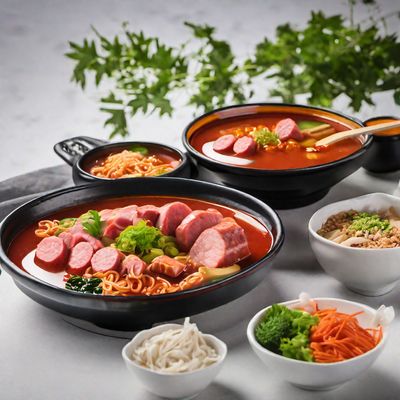
Ingredient
Instant coffee (beverage)
The Essence of Caffeine in a Cup
Instant coffee is made from coffee beans that have been roasted, ground, and brewed into a concentrated form. It is then dehydrated to create a soluble powder or granules. The resulting product is known for its strong aroma, bold flavor, and dark color. Instant coffee dissolves easily in hot water, making it a convenient choice for those seeking a quick and flavorful cup of coffee.
Origins and history
The concept of instant coffee dates back to the late 18th century when it was first developed in Britain. However, it wasn't until the early 20th century that instant coffee gained popularity and became widely available. Today, instant coffee is produced and consumed globally, with various brands and flavors catering to different preferences. Its convenience and long shelf life have made it a staple in many households and a popular choice for travelers and campers.
Nutritional information
Instant coffee is a low-calorie beverage that provides a moderate amount of caffeine. It contains trace amounts of essential nutrients such as potassium and magnesium. The nutritional content may vary depending on the brand and any added ingredients.
Allergens
Instant coffee does not typically contain allergens. However, some brands may add milk or other allergenic ingredients to their instant coffee products, so it is important to check the label for any potential allergens.
How to select
When selecting instant coffee, look for a reputable brand that uses high-quality coffee beans. Opt for a product that is well-sealed to ensure freshness and avoid any clumping or moisture. Additionally, consider the roast level and flavor profile that suits your taste preferences.
Storage recommendations
To maintain the freshness and quality of instant coffee, store it in an airtight container in a cool, dry place away from direct sunlight. Avoid exposing it to moisture or fluctuating temperatures, as this can affect the flavor and texture of the coffee. Once opened, consume the instant coffee within a reasonable timeframe to enjoy its full flavor.
How to produce
Instant coffee is produced through an industrial process that involves roasting, grinding, brewing, and dehydrating coffee beans. It requires specialized equipment and knowledge to achieve the desired quality and consistency. However, amateur coffee enthusiasts can experiment with making their own instant coffee by freeze-drying or spray-drying brewed coffee.
Preparation tips
Instant coffee can be prepared by dissolving the desired amount of coffee granules or powder in hot water. Adjust the strength of the coffee by adding more or less coffee to suit your taste. It can be enjoyed black or with the addition of milk, sugar, or other flavorings. Instant coffee is versatile and can be used in various recipes, such as desserts, smoothies, or as a flavoring in baked goods.
Culinary uses
Instant coffee is commonly used to make hot or iced coffee beverages. It is also a key ingredient in many coffee-flavored desserts, such as tiramisu or coffee-flavored ice cream. Additionally, instant coffee can be used as a flavor enhancer in savory dishes, such as stews or marinades.
Availability
Instant coffee is widely available in grocery stores, supermarkets, and online retailers worldwide.
More ingredients from this category

Coffee with milk or cream
The Perfect Blend of Boldness and Creaminess

Coffee espresso (beverage)
The Elixir of Energy

Iced coffee
Chilled Caffeine Delight

Coffee (weak strength) beverage
A Gentle Awakening

Coffee (strong) beverage
"Bold Brew: Unleashing the Power of Strong Coffee"

Coffee beverage decaffeinated
The Art of Decaffeination: Unveiling the Secrets of Coffee

Coffee (average strength) beverage
The Energizing Elixir
Recipes using Instant coffee (beverage)

Budae Jjigae with a Molecular Twist
Explosive Budae Jjigae: A Molecular Gastronomy Delight

Traditional Scottish Oatcakes
Hearty Oat Delights: Authentic Scottish Oatcakes

Mexican Chocolate Torte
Spicy Chocolate Fiesta Torte

Beef & Broccoli a la Española
Sabroso Bistec y Brócoli Español

Hot Water Corn Bread
Golden Crispy Corn Cakes

Gâteau Opera with a Twist
Decadent Delights: A Modern Twist on Gâteau Opera

Bavarian Chocolate Hazelnut Torte
Decadent Delight: Bavarian Chocolate Hazelnut Torte

Homemade Steamed Soup Dumplings
Savor the Delight: Homemade Steamed Soup Dumplings

Arab-inspired Spiced Gingerbread
Arabian Delights: Spiced Gingerbread with a Middle Eastern Twist